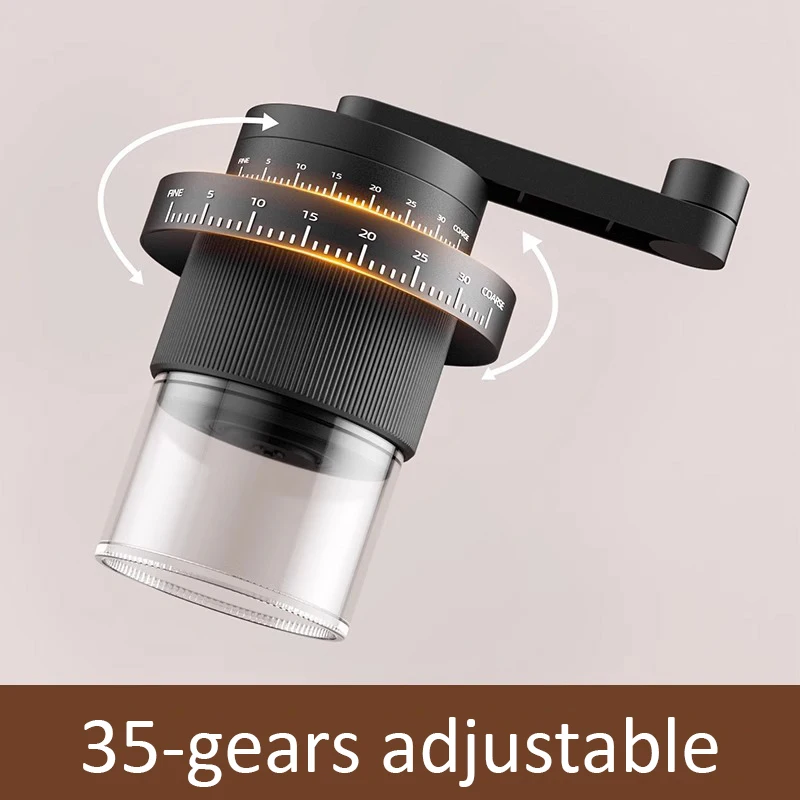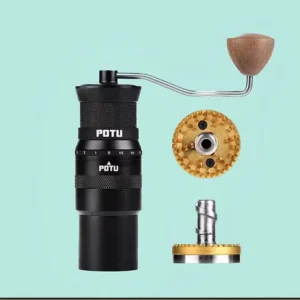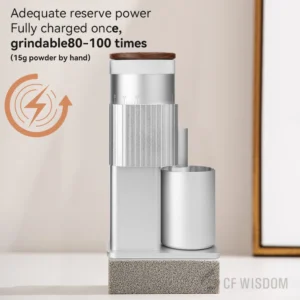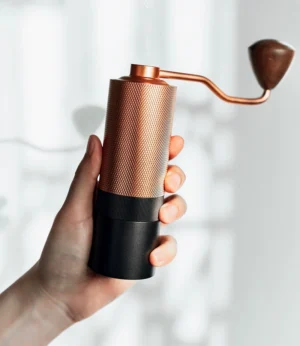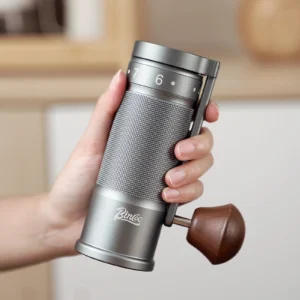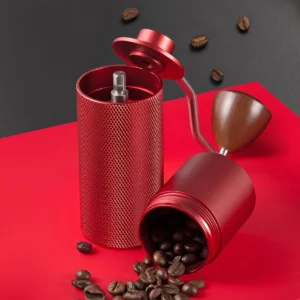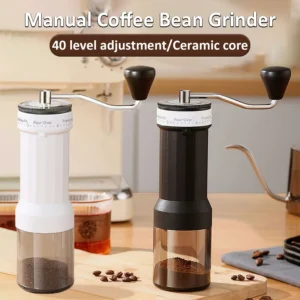Understanding the Fundamental Role of Grind Size in Espresso Extraction
Making espresso with a manual machine is a delicate art that depends heavily on precision. Unlike automatic machines that handle much of the process for you, manual espresso machines—those beautiful lever-operated, non-electric devices—put you in complete control of the pressure and extraction. This hands-on approach means that every variable becomes even more critical, and none more so than your coffee’s grind size.
When brewing with a manual espresso machine, the grind size directly affects:
- The resistance water encounters as it flows through the coffee
- The pressure that builds during extraction
- How quickly the water passes through the coffee bed
- Which flavor compounds are extracted from the beans
The relationship is straightforward yet profound: water interacts differently with coffee particles depending on their size. With manual machines, where you control the pressure application, having the right grind becomes even more crucial for consistent results. The scientific principle at work involves surface area—finer grounds have more surface area exposed to water, allowing for faster extraction of compounds.
Manual espresso machines are particularly sensitive to grind adjustments compared to their automatic counterparts. Even minor changes can dramatically alter your espresso’s taste and texture, which is why mastering espresso precision grind settings forms the foundation for exceptional manual brewing.
Finding that perfect grind isn’t a one-time achievement but rather an ongoing journey that requires understanding, patience, and consistent adjustment. For those serious about manual espresso, investing in quality manual espresso grinders specifically designed for the task makes this journey much more rewarding.
The Ideal Espresso Grind: Visual and Tactile Indicators
What does the perfect espresso grind actually look like? To the eye, properly ground espresso coffee resembles fine sand or granulated sugar—noticeably finer than table salt but not as powdery as flour. When you look closely, you should see consistent, tiny particles with minimal variation in size.
The texture offers additional clues:
- When rubbed between your fingers, it should feel somewhat like fine sand—slightly gritty but smooth
- When pinched, it should clump slightly due to the oils in the coffee, but still break apart when pressed
- It should not feel powdery like flour or cocoa powder (too fine)
- It should not feel rough like kosher salt or sugar crystals (too coarse)
In more precise terms, ideal espresso grind typically falls in the range of 200-400 microns (0.008-0.016 inches) in particle size. This is significantly finer than drip coffee but not as fine as Turkish coffee, which feels like powder.
It’s important to understand that the “ideal” espresso grind exists within a range rather than at an exact point. This range gives you flexibility to make minor adjustments based on your specific beans, machine, and taste preferences. Having a reliable reference like an ultimate espresso grind size chart can provide visual guidance as you develop your sensory understanding.
Achieving this level of consistency requires proper equipment—specifically fine adjustment hand grinders designed with espresso in mind, as they provide the precision necessary for the small adjustments that make a big difference in your cup.
The Science Behind Grind Size and Espresso Extraction
Understanding the science behind how grind size affects espresso extraction helps you make better decisions when troubleshooting or refining your technique.
When pressurized water meets coffee grounds, it begins dissolving and extracting compounds from the coffee particles. The size of these particles dramatically affects this process in several ways:
First, grind size creates resistance to water flow. Finer grounds pack together more tightly, creating greater resistance that builds the necessary pressure (ideally around 9 bars or 130 PSI) required for proper espresso extraction. Coarser grounds allow water to flow through too easily, preventing adequate pressure buildup.
Second, particle size determines surface area exposure. Finer grounds have more surface area exposed to water, which means compounds extract more readily. This is why extraction happens faster with finer grounds—there’s simply more coffee surface for the water to interact with.
Third, grind size influences extraction time. The ideal espresso shot pulls in approximately 18-30 seconds. If your grind is too coarse, water flows through too quickly (under-extraction), resulting in sour, weak, and watery espresso. If your grind is too fine, water struggles to flow through (over-extraction), creating bitter, harsh flavors and very slow drips—or worse, no flow at all.
The compounds in coffee extract in a particular order: acids first (bright, fruity flavors), then sugars (sweetness), and finally bitters and astringent compounds. The goal is to stop the process when you’ve extracted the perfect balance of these compounds—something directly controlled by your grind size paired with extraction time.
For those seeking deeper knowledge, how grind size affects espresso explores this relationship in greater scientific detail.
Common Grind-Related Issues and Their Solutions
Recognizing visual and taste indicators of grind issues helps you quickly identify and solve extraction problems:
| Problem | Visual Indicator | Cause | Solution | Taste Result |
|---|---|---|---|---|
| Shot pulls too fast (<15 seconds) | Thin, pale stream with little resistance | Grind too coarse | Make grind finer by 1-2 adjustment steps | Sour, weak, watery |
| Shot barely drips or doesn’t flow | Few drops or complete blockage | Grind too fine | Make grind coarser by 1-2 adjustment steps | Bitter, burnt, overly intense (if any liquid extracts) |
| Uneven extraction (spurting) | Stream sprays or comes from just one side | Uneven grind or distribution | Ensure consistent grind and distribution | Inconsistent, both sour and bitter notes |
| Initial normal flow then slows dramatically | Stream starts well but quickly diminishes | Grind has too many fines (inconsistent) | Improve grinder quality or adjust technique | Bitter finish with acceptable start |
| Blonding occurs too early | Stream turns pale yellow before 15 seconds | Grind too coarse | Make grind finer | Sour, underdeveloped flavor |
Beyond adjusting grind size, proper puck preparation is essential. Even the perfect grind can produce poor results if distributed unevenly in the portafilter. For a comprehensive approach to identifying and fixing these issues, our guide on mastering perfect espresso grind adjustments offers detailed troubleshooting strategies.
Remember that changes to grind size should be made incrementally—dramatic adjustments often overcorrect the problem and create new ones.
The Step-by-Step Dialing In Process for Manual Machines
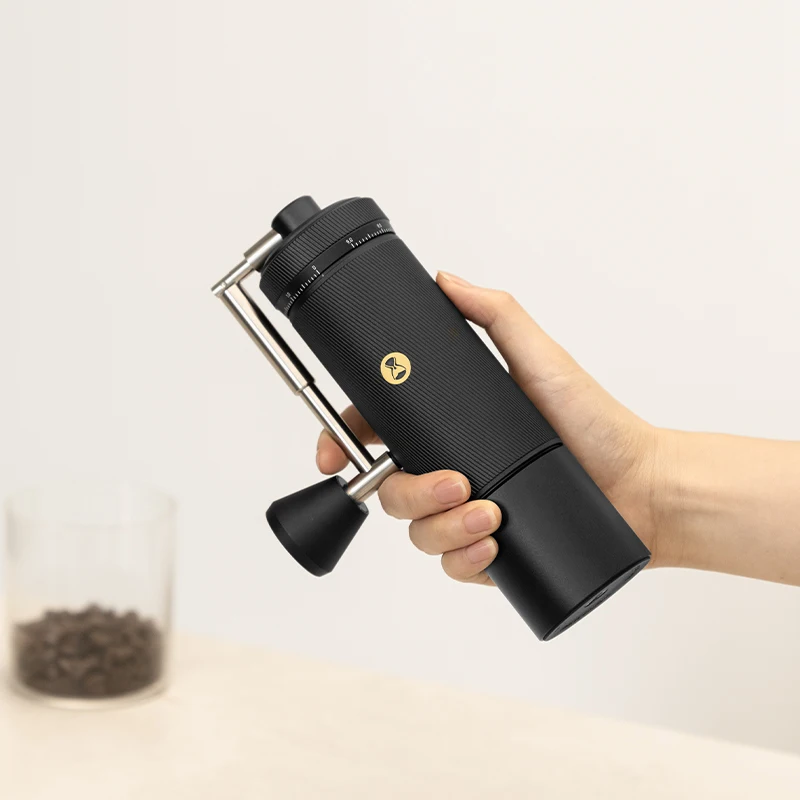
“Dialing in” refers to the methodical process of finding the optimal grind size for your specific beans and machine. This process is essential because each coffee bean variety, roast level, and machine may require slightly different settings. Follow this step-by-step approach for consistent results:
Start with a baseline setting – Begin with a fine grind that resembles granulated sugar. If your grinder has numbered settings, start in the middle of the “espresso” range.
Prepare a consistent dose – Measure exactly 18 grams (0.6 oz) of coffee for a double shot. Maintaining consistent dosing is crucial when isolating grind size as your test variable.
Pull a test shot – After proper distribution and tamping, pull an espresso and time it from when you start the extraction until you reach your target volume (typically 36 grams/1.3 oz for a double).
Assess the extraction time – Aim for 25-30 seconds for manual machines. Note the actual time.
Taste the result – Even if the timing seems off, tasting provides crucial information. Note whether it’s sour (under-extracted) or bitter (over-extracted).
Make a small adjustment – If the shot was too fast and sour, make the grind finer by one small increment. If it was too slow and bitter, go one increment coarser.
Repeat the process – Pull another shot with the new setting, keeping all other variables constant. Document your results (grind setting, extraction time, taste notes).
Fine-tune with micro-adjustments – Continue with increasingly smaller adjustments until you achieve the perfect balance of flavor.
Lock in your setting – Once you’ve found the sweet spot, note the exact grind setting for future reference with these beans.
This methodical approach is particularly important for manual espresso machines, where slight variations in technique can affect results. Espresso grind settings for the perfect shot provides additional guidance for refining this process.
For precise control during this process, many enthusiasts prefer using precision manual grinders with stepless adjustment mechanisms that allow for minute changes in grind size.
Key Variables That Influence Your Ideal Grind Size
While finding the right grind size is crucial, several other variables interact with your grind setting and may require you to make adjustments:
Bean Freshness: Coffee beans release carbon dioxide after roasting (degassing). Fresh beans (3-14 days off roast) contain more gas, which creates additional resistance during extraction. This means:
– Very fresh beans may require a slightly coarser grind
– Older beans (3+ weeks) might need a finer grind to compensate for reduced gas content
Roast Level: The degree of roast significantly impacts ideal grind size:
– Darker roasts are more brittle and produce more fines when ground, often requiring a slightly coarser setting
– Lighter roasts are denser and harder, typically needing a finer grind to achieve proper extraction
Humidity and Temperature: Environmental conditions affect coffee beans and grinding:
– Higher humidity can cause beans to absorb moisture, potentially requiring grind adjustments
– Temperature fluctuations can affect both the beans and manual grinder performance
Machine Characteristics: Each manual espresso machine has unique characteristics:
– Different lever systems create varying pressure profiles
– Some machines operate better with slightly finer or coarser grinds
– Basket size and shape influence ideal grind settings
User Technique: How you operate your manual machine matters:
– Lever pull speed and consistency affect extraction
– Pre-infusion technique may require grind adjustments
– Tamping pressure variations need compensating grind changes
Understanding these interactions helps explain why perfect grind setting for espresso isn’t a fixed number but rather a response to changing conditions. Becoming familiar with how these variables affect your specific setup allows you to make intelligent adjustments rather than random changes when troubleshooting.
Essential Equipment: Choosing the Right Grinder for Manual Espresso
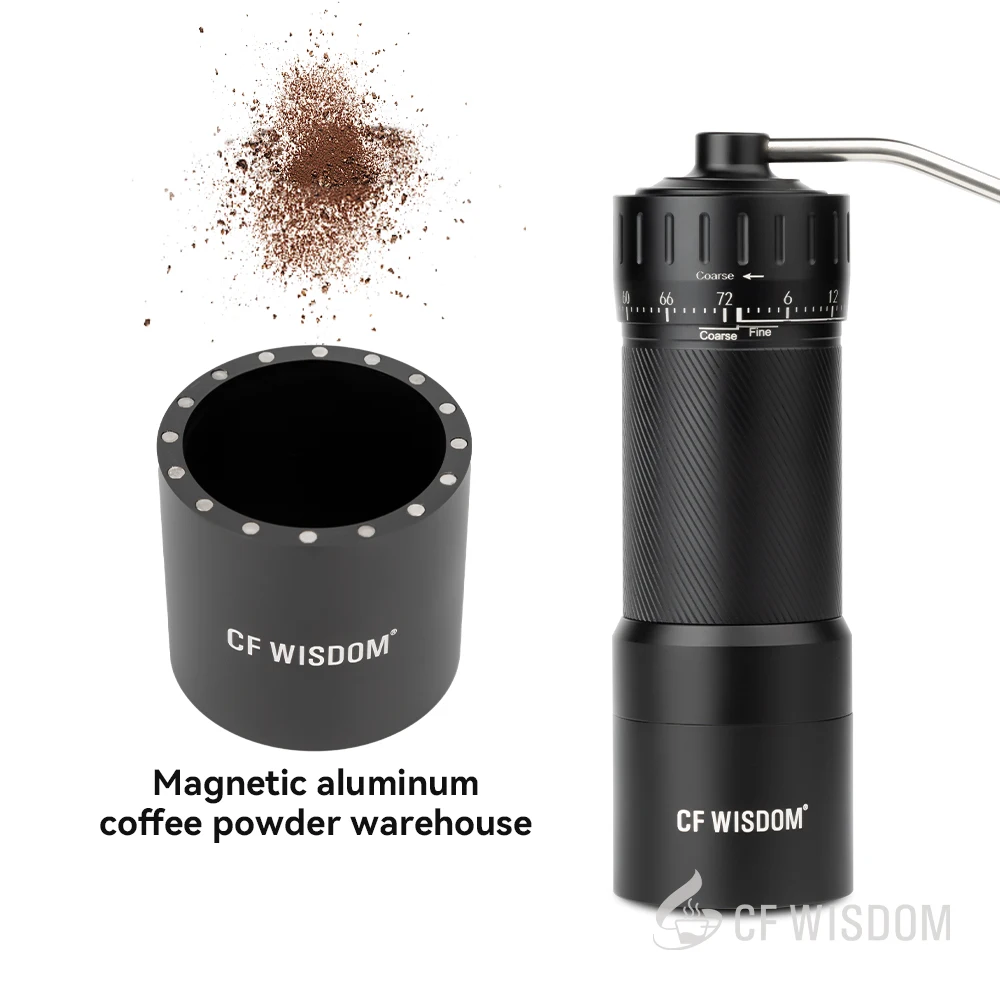
The quality of your grinder directly impacts your ability to achieve the perfect espresso grind. For manual espresso machines, the grinder requirements are particularly demanding:
Why Burr Grinders Are Essential:
– Burr grinders crush beans between two textured surfaces (burrs), producing consistent particle sizes
– Blade grinders chop beans randomly, creating wildly inconsistent particles that extract unevenly
– Only burr grinders offer the precision and consistency necessary for espresso extraction
Critical Grinder Features for Espresso:
– Burr size: Minimum 38-40mm (1.5-1.6in) burrs provide better consistency
– Adjustment mechanism: Stepless adjustment allows infinite fine-tuning between settings
– Build quality: Sturdy construction minimizes burr wobble for consistent grinding
– Retention: Low retention design reduces waste and improves dose consistency
Burr Types and Their Impact:
– Conical burrs: Generally more affordable, produce slightly more particle size variation (some prefer this for traditional espresso flavor)
– Flat burrs: Often produce more uniform particles, potentially creating cleaner flavor profiles
– Material matters: Steel burrs are sharper but wear faster; ceramic burrs stay sharp longer but are more brittle
Manual vs. Electric Considerations:
– Quality manual grinders can match or exceed mid-range electric grinders in grind consistency
– Manual grinding requires effort but offers greater portability and often better value
– Premium manual grinders with precision bearings and stabilized burrs excel at espresso grinding
Fine Adjustment Hand Grinder, Precision Manual Grinder, Travel Coffee Grinder
Price range: $185.11 through $494.63 Select options This product has multiple variants. The options may be chosen on the product pageHand Burr Grinder, Hand Crank Coffee Grinder, Manual Espresso Grinder, Portable Coffee Grinder
Price range: $262.72 through $300.22 Select options This product has multiple variants. The options may be chosen on the product pageHand Burr Grinder, Manual Coffee Grinder Stainless Steel, Precision Manual Grinder
Price range: $183.64 through $187.52 Select options This product has multiple variants. The options may be chosen on the product pageCeramic Burr Coffee Grinder, Hand Burr Grinder, Hand Crank Coffee Grinder, Manual Coffee Bean Grinder
Price range: $59.17 through $59.96 Select options This product has multiple variants. The options may be chosen on the product page
Our collection of hand burr grinders represents exceptional quality tools specifically designed to meet the demands of manual espresso preparation. When paired with your manual espresso machine, these grinders provide the foundation for achieving professional-quality results.
For those passionate about espresso, investing in a dedicated manual coffee grinder for espresso is often more beneficial than purchasing a multi-purpose grinder that compromises on espresso performance.
Perfecting Your Grinding Technique
Even with the perfect grinder, your technique significantly impacts the consistency and quality of your ground coffee:
Single-dose grinding: Measure beans precisely before grinding rather than using the grinder’s hopper. This ensures each dose is fresh and allows you to adjust for different coffees.
Consistent grinding motion: When using manual grinders, maintain a steady, smooth rotation rather than jerky movements that can create inconsistent particle sizes.
Check for clumping: Espresso-fine grounds naturally clump together due to static and oils. Gently break up clumps before transferring to the portafilter.
RDT method: Lightly mist beans with a spray bottle before grinding (Ross Droplet Technique) to reduce static and improve consistency.
Grind directly into dosing cup/portafilter: Minimize transfers to reduce mess and maintain dose accuracy.
Monitor resistance changes: Pay attention to how the grinding feels—resistance should increase as beans break down but remain consistent throughout.
Clean regularly: Remove old coffee residue from burrs and grind path to prevent stale flavors and ensure consistent grind size.
These techniques complement your equipment choice and grind setting. The quality espresso coffee hand grinders available at Savor Suite are designed to make these techniques easier to implement, with features like ergonomic handles, smooth bearings, and anti-static materials.
Remember that grinding technique develops with practice—pay attention to the process rather than just the outcome, and you’ll develop an intuitive understanding of how your grinder performs.
Distribution and Tamping: Complementing Your Grind Size
The perfect grind size alone won’t guarantee great espresso—proper distribution and tamping are essential companions to your grinding efforts:
Even Distribution Techniques:
– WDT Method (Weiss Distribution Technique): Use a fine tool (like a dissected paper clip or specialized tool) to gently stir grounds in the portafilter, breaking up clumps and creating even density
– Tap Method: Gently tap the side of the portafilter to settle grounds evenly
– Distribution Tools: Use a leveling tool to create a perfectly flat bed before tamping
Proper Tamping Fundamentals:
– Apply approximately 30 pounds (13.6 kg) of pressure—enough to create resistance but not excessive
– Maintain a perfectly level tamp to prevent channeling
– Focus on consistency rather than extreme pressure
Common Problems and Solutions:
– Donut extractions (center dry, edges flowing): Usually indicates poor distribution rather than incorrect grind
– Channeling (water finding paths of least resistance): Often caused by uneven distribution or tamping, not just grind issues
– Side channeling: May indicate improper fit between tamper and basket or uneven distribution against the walls
When you’ve mastered the correct grind setting for espresso and pair it with proper distribution and tamping, you create the ideal conditions for water to extract evenly through the entire coffee puck. This holistic approach significantly improves consistency and flavor quality.
Remember that distribution and tamping should compensate for the natural tendencies of ground coffee (clumping, static, etc.) rather than fighting against an inappropriate grind size.
Expert Tips for Consistent Results With Manual Machines
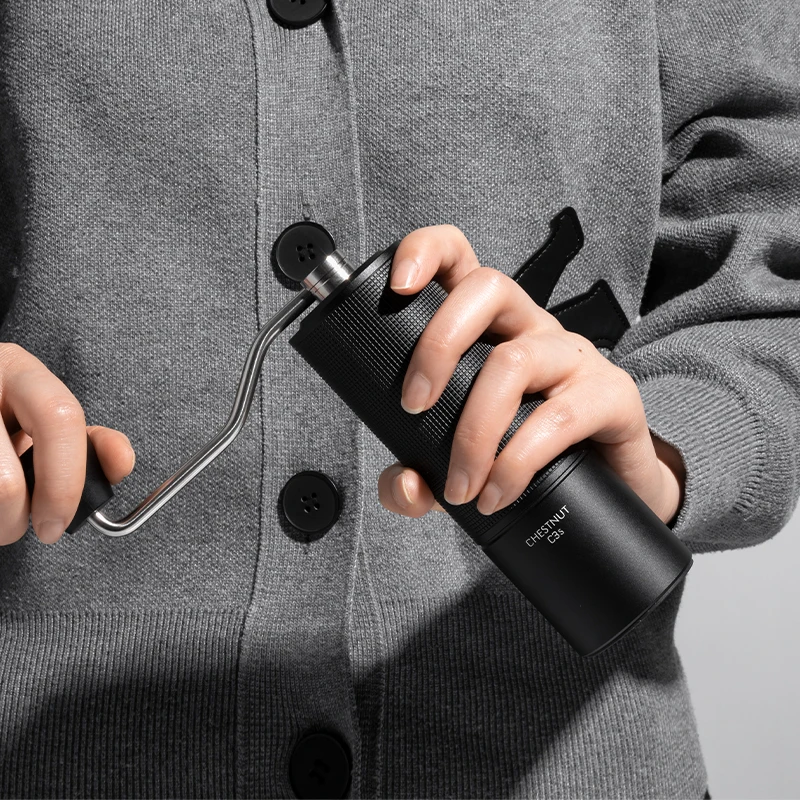
Once you’ve mastered the basics, these advanced techniques will help you achieve professional-level consistency with your manual espresso setup:
Temperature management: Preheat your portafilter and cup thoroughly—temperature fluctuations can mask grind issues and create inconsistent results.
Grind fresh for each shot: Coffee begins oxidizing immediately after grinding, significantly affecting extraction. For optimal results, grind only what you need right before brewing.
Consider pre-infusion techniques: Many manual machines allow for gentle pre-wetting of the grounds before full pressure. This helps achieve even extraction and can sometimes compensate for minor grind inconsistencies.
Log your successes: Create a coffee journal documenting grind settings, bean origins, roast dates, and tasting notes. This reference becomes invaluable as you work with different coffees.
Pressure profiling: Advanced users can intentionally vary pressure throughout extraction by controlling lever speed—sometimes requiring slightly different grind adjustments.
Specific machine adjustments:
- Flair users often benefit from slightly finer grinds and gentle pre-infusion
- Lever machines like La Pavoni may require coarser grinds than spring-lever counterparts
Machines with larger baskets generally need more consistent grinds due to deeper coffee beds
Consider ambient humidity: In very dry conditions, adding a single drop of water to your beans before grinding (known as RDT method) can reduce static and improve consistency.
These professional techniques build upon the foundation of precision grind adjustment for espresso and become particularly important when working with challenging coffee varieties or pursuing specific flavor profiles.
Is Your Grinder Holding You Back? Signs You Need to Upgrade
How do you know if your grinder is limiting your espresso quality? Look for these telling signs:
Inconsistent Shot Times:
Are your shots running at wildly different times despite identical settings and technique? Your grinder may be producing inconsistent particle sizes.
Unable to Make Fine Enough Adjustments:
Do you find yourself stuck between settings—one too coarse and the next too fine? Quality espresso grinders offer much finer adjustment increments.
Excessive Fines Production:
Does your coffee puck turn muddy and choke the machine even at coarser settings? Poor grinders often produce too many micro-particles (fines) that restrict flow.
Clumpy, Static-Filled Grounds:
While some clumping is normal for espresso grinds, excessive clumping that’s difficult to distribute indicates poor grind quality.
Heating During Operation:
Does your grinder get hot while grinding? This can affect grind consistency and potentially damage the coffee’s flavor compounds.
Limited Range:
A quality espresso grinder should handle the full spectrum from fine espresso to coarse French press grinds. Limited range restricts your brewing options.
Understanding the differences between manual and automatic espresso grinder settings can help you decide which upgrade path makes sense for your brewing style.
Remember that while grinder quality matters significantly, there’s a point of diminishing returns. Entry-level burr grinders struggle with espresso, mid-range grinders perform adequately, and premium grinders offer incremental improvements that matter most to experienced users pursuing perfect extraction.
Frequently Asked Questions About Espresso Grind Size
Can I use pre-ground coffee in a manual espresso machine?
While possible, pre-ground coffee is rarely the right size and goes stale quickly. Manual machines are particularly sensitive to grind freshness and size, making pre-ground coffee generally unsuitable for quality results.
How often should I adjust my grind throughout the day?
You may need minor adjustments even within the same day as ambient humidity changes, beans age, or your grinder warms up. Professional baristas often make tiny adjustments several times during busy shifts.
Why does my grind size need to change with different beans?
Bean density, moisture content, origin, and roast level all affect how water flows through the coffee. Lighter roasts typically need finer grinds than darker roasts, and aged beans usually require finer grinds than fresh ones.
Should I adjust grind or dose first when troubleshooting?
Always start by ensuring your dose is consistent before adjusting grind. Once you’ve established a consistent dose, grind adjustments should be your primary tool for dialing in extraction.
Do burrs need “seasoning” before they produce consistent grinds?
Yes, new burrs often have microscopic manufacturing irregularities that smooth out after grinding 5-10 pounds of coffee. During this break-in period, you may notice your grind becoming more consistent.
How do I know if my espresso is under or over-extracted?
Under-extracted espresso tastes sour, sharp, and lacks sweetness. Over-extracted espresso tastes bitter, astringent, and sometimes hollow. Perfect extraction balances acidity with sweetness and offers complex flavors.
Will the perfect grind setting stay the same forever?
No—even after finding an ideal setting, you’ll need adjustments as beans age, seasons change, or your grinder’s burrs wear. The perfect grind size for manual espresso is a moving target requiring ongoing attention.
Final Thoughts: The Journey to Espresso Perfection
Mastering the perfect grind size for your manual espresso machine isn’t a destination—it’s an ongoing journey of refinement and adjustment. Unlike many kitchen appliances where you “set it and forget it,” manual espresso preparation rewards those who embrace the process and develop their sensory skills.
Remember that while there are guidelines and starting points, your personal taste preferences should ultimately guide your decisions. Some coffee enthusiasts prefer the bright acidity that comes with slightly faster extractions, while others enjoy the rich sweetness from shots that run a bit longer. The technical “perfection” means little if it doesn’t create a cup you love.
The beauty of manual espresso preparation lies in this hands-on craft. Every variable—from bean selection to grind size, distribution, tamping, and lever control—comes together to create a uniquely rewarding experience that automatic machines simply can’t match.
As you continue mastering espresso grind size, you’ll develop an intuitive understanding of how small changes affect your cup. This skill transfers across different beans, machines, and brewing methods, deepening your appreciation for the remarkable complexity hidden within the humble coffee bean.

